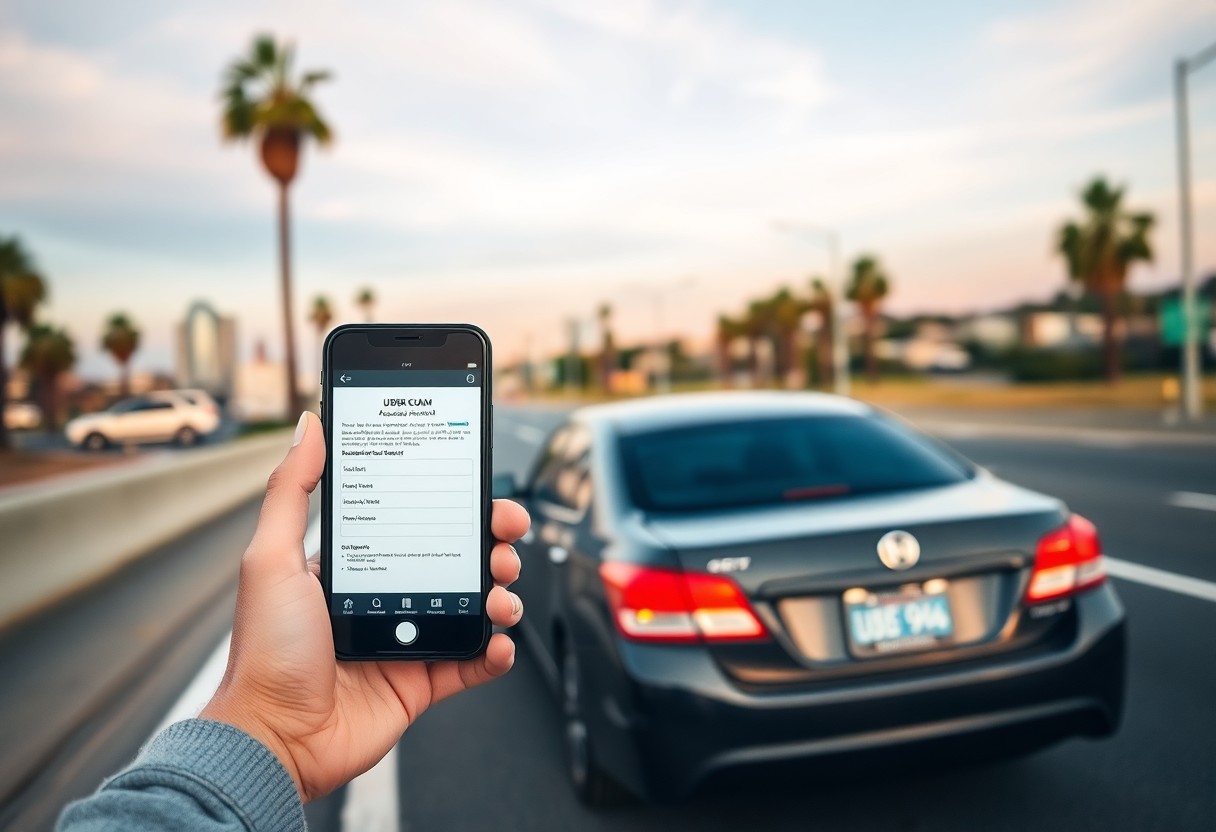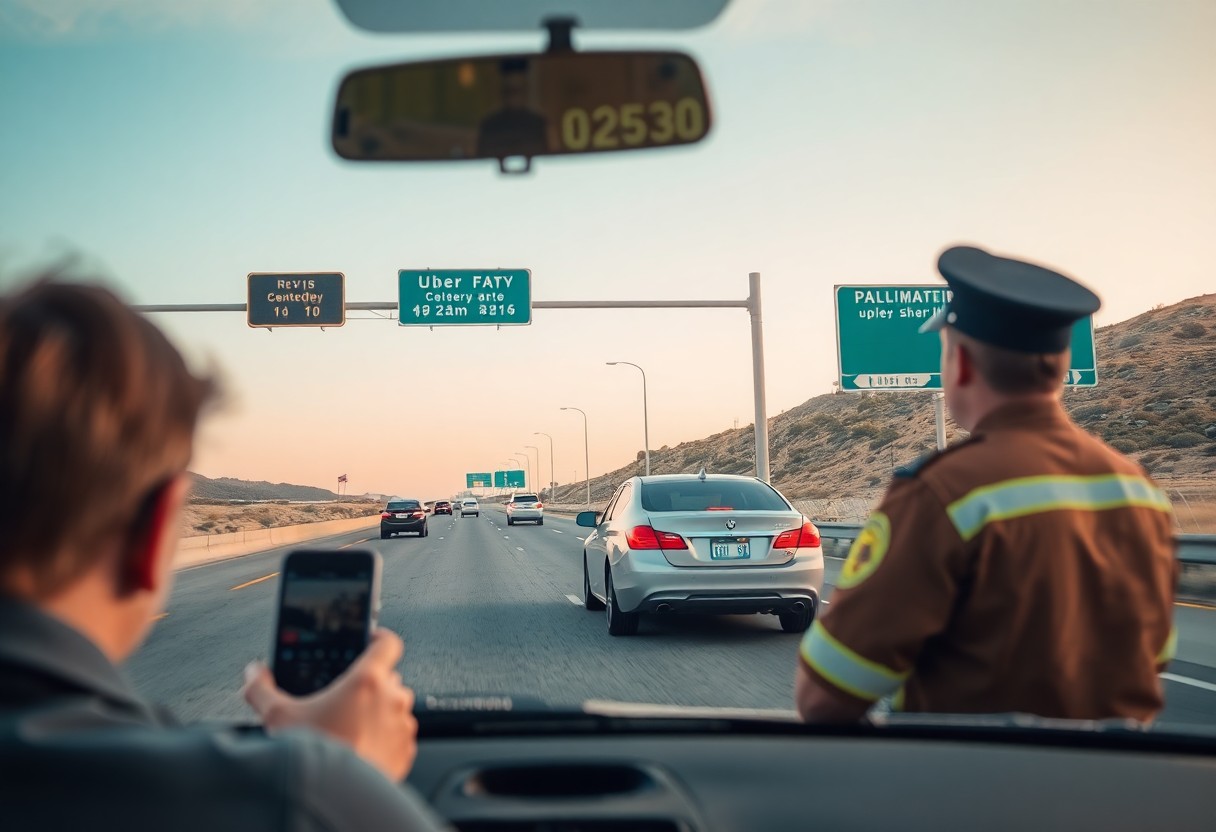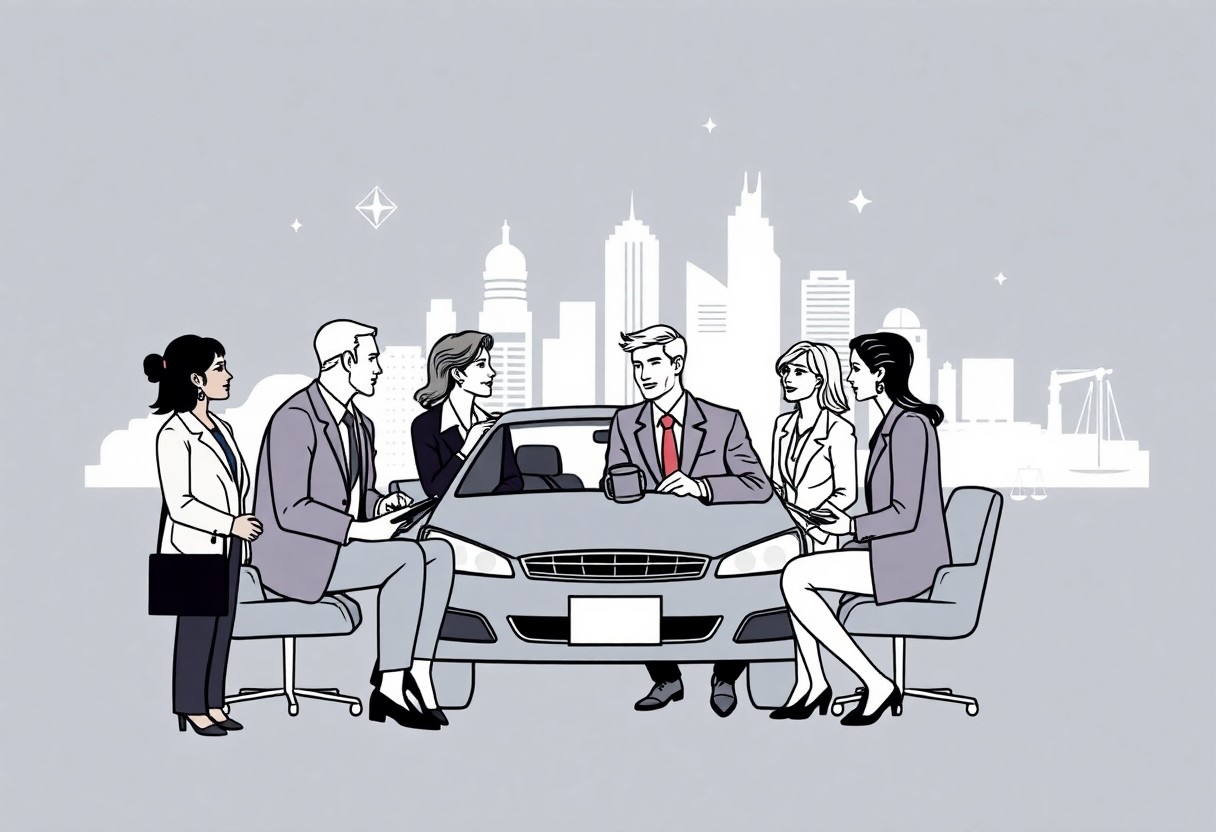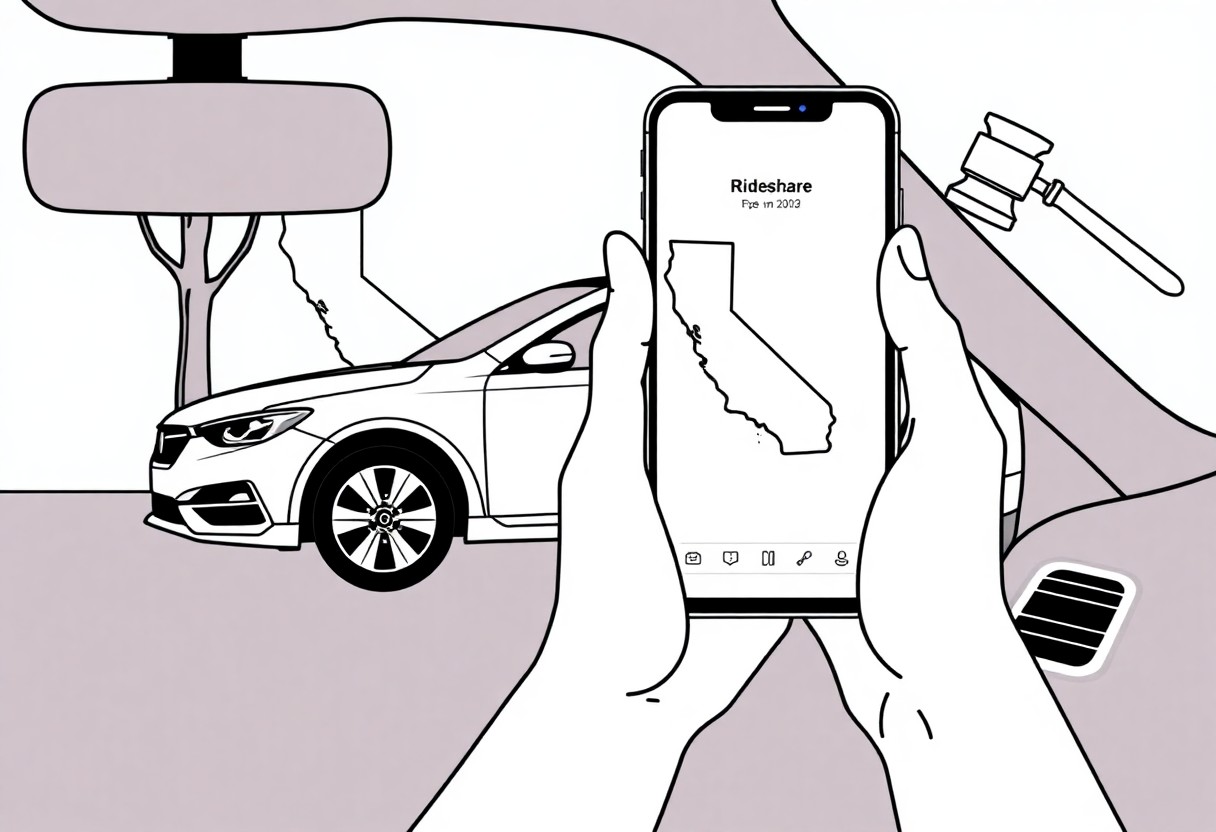Uber vehicles are an increasingly common sight on California roads, and as a driver, it’s important for you to understand the unique challenges and responsibilities that come with sharing the road with them. These rideshare vehicles can unexpectedly stop or start to pick up passengers, posing a potential hazard for both drivers and pedestrians. Staying alert and maintaining a safe distance from Uber cars can enhance your safety as well as the safety of others. This post will provide you with important tips to navigate your daily commute effectively while sharing the road with Uber vehicles.
Key Takeaways:
- Awareness: Always be attentive to the presence of Uber vehicles, as they may make frequent stops to pick up or drop off passengers.
- Yielding: Give Uber drivers the right of way when they are merging back into traffic after dropping off passengers.
- Patience: Allow extra time when navigating through areas with heavy ride-sharing activity, as drivers may make sudden stops or lane changes.
Understanding Uber Vehicles
To navigate the road safely alongside Uber vehicles, it’s vital to understand the types of services they offer. Uber provides various options to cater to different needs and preferences, ensuring that passengers and drivers can make informed choices. By being aware of these options, you can anticipate the behavior of Uber vehicles and drive more safely around them.
Types of Uber Services
After examining the range of Uber services, you will find different categories, each designed for specific situations. The following table summarizes the primary types of Uber services available:
| UberX | Standard service for everyday rides. |
| UberXL | Affordable ride option for larger groups. |
| Uber Comfort | More legroom and a newer vehicle. |
| Uber Pool | Shared rides with other passengers for lower fares. |
| Uber Black | Premium service with high-end vehicles. |
This knowledge will greatly assist you in understanding how to safely share the roads with Uber vehicles while avoiding potential hazards.
Regulations Governing Rideshare Vehicles
With the rise of ridesharing services like Uber, various regulations have been implemented to ensure safety on the roads. Each state, including California, has specific guidelines governing how rideshare vehicles operate. These regulations involve driver background checks, vehicle inspections, and insurance coverage that must be maintained by drivers while they are on the job. Familiarizing yourself with these regulations will help you better understand the responsibilities that rideshare drivers have when operating their vehicles.
And it’s important to note that rideshare drivers must adhere to both state and local regulations while on the road. This includes maintaining a valid driver’s license, having the appropriate insurance coverage, and undergoing regular vehicle inspections. Additionally, Uber emphasizes passenger safety by conducting comprehensive background checks on drivers before allowing them to operate. By understanding these regulations, you can navigate the road more confidently knowing that there are measures in place to protect both you and rideshare drivers.
The Importance of Sharing the Road
There’s a growing need for all drivers in California to understand the dynamics of sharing the road with rideshare vehicles like Uber. As these vehicles become more prevalent in urban areas, they can affect traffic patterns and road safety. Keeping your cool and practicing patience when interacting with rideshare drivers can significantly contribute to a more harmonious driving environment. Being mindful of their presence not only helps your own driving experience but also facilitates a smoother experience for other road users.
Reducing Road Rage and Accidents
Between the busy streets of California and the rising number of Uber vehicles on the road, instances of road rage can escalate quickly if not managed effectively. It is vital to remain calm and composed during your daily commute, especially when Uber drivers make sudden stops or changes in direction. By understanding that rideshare drivers often operate under different conditions and may have to pick up or drop off passengers at unexpected locations, you can minimize frustration and help decrease the chances of tension escalating into dangerous situations.
Enhancing Safety for All Road Users
After factoring in the various dynamics of rideshare vehicles on the road, it’s imperative to focus on enhancing the safety of all road users. Maintaining a safe distance from Uber vehicles and being cautious when merging or changing lanes can significantly reduce potential accidents. Also, staying alert for sudden stops or slowdowns, common in areas where rideshare pickups and drop-offs frequently occur, will help you navigate the streets safely.
At the end of the day, promoting responsible driving practices can enhance safety for everyone on the road, including yourself, passengers, and pedestrians. By keeping a safe distance from Uber vehicles, adjusting your speed appropriately, and staying aware of passengers entering or exiting the car, you not only protect yourself but also contribute to overall road safety. This level of vigilance helps create a more enjoyable and secure driving experience for all parties involved.
Tips for California Drivers
Not knowing how to navigate the road while sharing it with Uber vehicles can lead to unwanted accidents or traffic disruptions. Here are some practical tips to ensure a smooth driving experience:
- Maintain a safe following distance from Uber vehicles.
- Be aware of frequent stops, especially in urban areas.
- Watch for sudden lane changes without warning.
- Always yield to pedestrians who may enter the crosswalk.
- Stay alert for rideshare cars pulling over to pick up or drop off passengers.
Recognizing these behaviors can help you adjust your driving and enhance the safety of all road users.
Safe Distancing from Uber Vehicles
By giving Uber vehicles adequate space, you significantly reduce the chances of rear-end collisions or sudden braking incidents. Aim to keep at least a three-car length distance from any rideshare vehicle, especially when you notice their brake lights flashing. This distance becomes even more important in busy traffic where Uber drivers may often stop unexpectedly to pick up or drop off passengers.
Plan your turns and lane changes in advance so that you won’t have to brake suddenly. For instance, if you see a rideshare car pulling over to the curb, be prepared to either slow down or change your lane safely. Always exhibit caution and give yourself ample room to maneuver around rideshare vehicles safely, as this promotes a smoother flow of traffic.
Using Turn Signals and Signaling Intentions
Behind the wheel, using turn signals is not only a matter of courtesy but also an important aspect of defensive driving. When driving near Uber vehicles, always make sure to signal your intentions well in advance of any lane changes or turns. This practice allows rideshare drivers to anticipate your next move and prevent sudden stops or abrupt lane changes that could lead to accidents.
Safe signaling is especially vital in areas with a high volume of rideshare activity, as drivers may stop unexpectedly. Always use your turn signals when changing lanes or turning to alert both Uber drivers and other road users to your intentions. This simple but effective practice can significantly enhance road safety and reduce misunderstandings between you and the rideshare vehicles around you. Recognizing that clear communication on the road is important will lead to a safer environment for everyone involved.
Common Misunderstandings About Uber Drivers
Assumptions About Driver Behavior
Many people tend to make assumptions about Uber drivers that can lead to misunderstandings on the road. For instance, you might believe that Uber drivers are constantly distracted by navigation apps and phone alerts. While it’s true that they rely on technology for directions, professional drivers focus on the road and are trained to minimize distractions while providing safe rides. Understanding this can help you feel more at ease when sharing the road with them.
Between the perception that Uber drivers engage in reckless driving to meet passenger demands and the reality that many are committed to upholding Uber’s strict community guidelines, it’s crucial to recognize that their driving behavior may not be as erratic as you think. Many drivers prioritize safety, often going above and beyond to ensure that they and their passengers are protected while on the road.
The Role of Technology in Ridesharing
Technology plays an integral role in the ridesharing experience, influencing how Uber drivers operate on the road. It is not only a tool for navigation but also a platform that fosters communication between you and your driver. Understanding that these technologies are designed to enhance safety and efficiency can change your outlook on ridesharing. For example, GPS routing helps drivers avoid heavy traffic and adjust their routes accordingly, while in-app safety features, such as the ability to share trip details with a friend, can provide added reassurance for both parties.
At the core of ridesharing, the technology facilitates a seamless interaction between passengers and drivers. Features like real-time tracking and an in-app emergency button are aimed at providing a safer experience. These advancements mean you can view your driver’s location before they arrive and track the trip in real time, which can significantly enhance your peace of mind. Embracing these innovations allows you to share the road with Uber vehicles more confidently and knowledgeably.
The Impact of Ridesharing on Traffic
Increased Congestion and Its Effects
All California drivers have likely experienced the growing presence of rideshare vehicles. One consequence of this surge is increased congestion in urban areas. With thousands of Uber and Lyft cars on the road, particularly during peak hours, the streets can feel more crowded. This influx not only leads to longer wait times for you but can also complicate the flow of traffic, making navigation more challenging. As rideshare vehicles frequently engage in stopping and starting to pick up passengers, they create unexpected delays that can ripple through traffic patterns.
Moreover, this congestion can exacerbate air pollution issues, impacting your health and the environment. More vehicles on the road contribute to higher levels of greenhouse gas emissions, and as ridesharing becomes a greater part of the transportation landscape, it’s important to consider how these vehicles interact with existing traffic. These factors can not only affect your daily commuting experience but also contribute to the broader concerns of urban mobility and sustainability.
Strategies to Mitigate Traffic Issues
Mitigate the impacts of ridesharing on traffic by adopting some practical strategies. These include opting for public transportation whenever feasible to reduce the number of cars on the road and encouraging carpooling among friends and coworkers as a way to share rides instead of relying on solo trips. Additionally, using rideshare services only when necessary can help manage the sheer volume of vehicles during high-traffic periods. By planning your trips during off-peak hours, you can participate in easing congestion as well.
This collaborative effort among drivers can substantially lessen the pressures of traffic congestion in California. By understanding the dynamics of ridesharing and adjusting your habits, you contribute to a smoother driving environment for yourself and others. Staying informed about local traffic patterns and common rideshare hotspots can further enhance your driving experience and ensure your safety on the road.
Case Studies: Incidents Involving Uber Vehicles
Your awareness of the incidents involving Uber vehicles can significantly benefit your safety while driving in California. Here are several notable case studies showcasing various accidents that have occurred and their implications:
- In 2019, an Uber vehicle was involved in a collision with a motorcycle in Los Angeles, resulting in the motorcyclist sustaining severe injuries. Data reported a failure to yield at a left turn.
- A pedestrian was struck by an Uber vehicle in San Francisco in 2020, leading to discussions about the safety protocols drivers should follow while navigating crowded areas.
- In 2021, an Uber driver was found at fault for a rear-end collision on a busy freeway in San Diego. The incident highlighted distractions caused by phone usage.
- Research conducted in 2022 revealed that Uber vehicles were involved in around 15% of traffic accidents in urban areas, often attributed to the rapid pick-up and drop-off demands in congested situations.
Analysis of Accidents and Their Causes
On examining the circumstances surrounding these accidents, it becomes evident that certain factors contribute significantly to incidents involving Uber vehicles. Frequent causes include driver distraction due to smartphone usage, inexperienced navigation of high-traffic areas, and sometimes inadequate communication between riders and drivers regarding pick-up locations. Each of these elements plays a vital role in determining the safety of both Uber drivers and other road users.
Your understanding of these underlying causes offers an opportunity for personal improvement. By paying close attention to your surroundings and ensuring you are not contributing to potential distractions, you can help foster a safer driving environment. It is crucial to be aware of how rideshare dynamics can change the behavior of other drivers on the road.
Lessons Learned from Real-Life Scenarios
Uber’s evolving operations provide numerous lessons that can enhance your driving strategies. Your safety and that of passengers are paramount; therefore, understanding how Uber vehicles interact with regular traffic can help you avoid potential accidents. Each accident highlights the need for heightened vigilance, especially in urban settings where rideshare services operate frequently.
In addition to fostering awareness, drivers can take specific preventive measures based on the experiences of others. Practicing patience, especially when navigating areas with high rideshare activity, can mitigate risks. Ensuring safe distance from Uber vehicles during pick-up and drop-off zones, coupled with an emphasis on attentive driving habits, can lead to a more secure road-sharing experience. Understanding that increased awareness of rideshare operations can lead to fewer accidents is a positive step toward safer driving for everyone. By making these efforts, you contribute to a culture of safety on California roads.
Summing Up
With these considerations in mind, understanding how to safely share the road with Uber vehicles is imperative for every California driver. You must stay vigilant as rideshare drivers often make quick stops, change lanes unexpectedly, and may not always signal effectively. By remaining aware of your surroundings and giving rideshare vehicles the space they need, you can contribute to a safer driving environment for everyone on the road. Also, familiarizing yourself with local laws regarding rideshare services can empower you to respond to any potential hazards more effectively.
As you navigate the streets and highways of California, keep in mind that patience and courtesy go a long way. Sharing the road is not just about following traffic rules but also about being considerate of the various driving behaviors you might encounter, especially from rideshare vehicles. By adopting a more understanding and cooperative approach, you can help ensure that all road users—whether they are in a personal vehicle, a taxi, or an Uber—can travel safely and efficiently together.


















